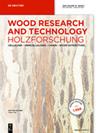桦木木屑的硫酸盐蒸煮:孔隙与散装液中溶解有机物的差异
IF 1.6
3区 农林科学
Q2 FORESTRY
引用次数: 0
摘要
摘要研究了桦木木质素在硫酸盐制浆过程中的脱木质素作用,主要包括浸渍和蒸煮两个步骤。用白液、白液+ NaCl、水或NaCl水溶液浸渍木屑。然后,所有样品在相同的恒定成分烹饪条件下,在批量高压灭菌器中烹饪芯片。在不同的制浆次数后,收集纸浆和两份黑液(散装液和代表木屑和纤维内部的离心液),分析木质素和碳水化合物的含量。从选定的样品中沉淀出溶解的木材成分,并对其组成、分子量分布和结构基序进行表征。浸渍液中的烹饪化学物质导致在烹饪过程中更快地脱木质素和去除木聚糖。管腔中木质素和木聚糖的含量高于体中。浓度曲线还显示溶解物质随时间在管腔内积累,表明从管腔到体的质量运输有明显限制。进一步的分析表明,与管腔液相比,随着制浆时间和体积的增加,溶解物质的破碎/降解程度更高,这可以通过核磁共振光谱中较低的分子量和化学位移的变化来证明。本文章由计算机程序翻译,如有差异,请以英文原文为准。
Kraft cooking of birch wood chips: differences between the dissolved organic material in pore and bulk liquor
Abstract The delignification of birch chips during kraft pulping was investigated, targeting both the impregnation and cooking steps. Wood chips were impregnated using white liquor, white liquor + NaCl, water or NaCl aqueous solution. Then, the chips were cooked in batch autoclaves applying the same constant composition cooking conditions for all samples. Pulp and two fractions of black liquor (bulk liquor and centrifuged liquor representing the liquor inside the wood chips and fibers) were collected after different pulping times and analyzed for lignin and carbohydrate content. The dissolved wood components were precipitated from selected samples and characterized with respect to composition, molecular weight distribution and structural motifs. Cooking chemicals in the impregnation liquors led to faster delignification and xylan removal during cooking. Higher contents of lignin and xylan were measured in the lumen than in the bulk. The concentration profiles also showed accumulation of dissolved material in the lumen over time, suggesting significant mass transport limitation from lumen to bulk. Further analysis revealed higher fragmentation/degradation of dissolved material with increasing pulping time and in the bulk when compared to the lumen liquor, as demonstrated by the lower molecular weights and the changes in chemical shifts in the NMR spectra.
求助全文
通过发布文献求助,成功后即可免费获取论文全文。
去求助
来源期刊

Holzforschung
工程技术-材料科学:纸与木材
CiteScore
4.60
自引率
4.20%
发文量
83
审稿时长
3.3 months
期刊介绍:
Holzforschung is an international scholarly journal that publishes cutting-edge research on the biology, chemistry, physics and technology of wood and wood components. High quality papers about biotechnology and tree genetics are also welcome. Rated year after year as one of the top scientific journals in the category of Pulp and Paper (ISI Journal Citation Index), Holzforschung represents innovative, high quality basic and applied research. The German title reflects the journal''s origins in a long scientific tradition, but all articles are published in English to stimulate and promote cooperation between experts all over the world. Ahead-of-print publishing ensures fastest possible knowledge transfer.
 求助内容:
求助内容: 应助结果提醒方式:
应助结果提醒方式:


